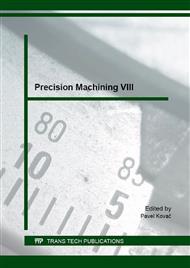[1]
L. Gang, Study on deformation of titanium thin-walled part in milling process, Journal of materials processing technology 209 (2009) 2788-2793.
DOI: 10.1016/j.jmatprotec.2008.06.029
Google Scholar
[2]
T.C. Bera, K.A. Desai, P.V.M. Rao, Error compensation in flexible end milling of tubular geometries, Journal of Materials Processing Technology 211 (2011) 24-34.
DOI: 10.1016/j.jmatprotec.2010.08.013
Google Scholar
[3]
K. Kolluru, D. Axinte, Coupled interaction of dynamic responses of tool and workpiece in thin wall milling, Journal of materials processing technology 213 (2013) 1565-1574.
DOI: 10.1016/j.jmatprotec.2013.03.018
Google Scholar
[4]
S. Seguy, G. Dessein, L. Arnaud, Surface roughness variation of thin wall milling, related to modal interactions, International Journal of Machine Tools & Manufacture 48 (2008) 261-274.
DOI: 10.1016/j.ijmachtools.2007.09.005
Google Scholar
[5]
H. Ning, W. Zhigang, J. Chengyu, Z. Bing, Finite element method analysis and control stratagem for machining deformation of thin-walled components, Journal of Materials Processing Technology 139 (2003) 332-336.
DOI: 10.1016/s0924-0136(03)00550-8
Google Scholar
[6]
P. Michalik , J. Zajac, M. Hatala, D. Mital, V. Fecova, Monitoring surface roughness of thin-walled components from steel C45 machining down and up milling, Measurement 58 (2014) 416-428.
DOI: 10.1016/j.measurement.2014.09.008
Google Scholar
[7]
F.J. Campa, L.N. Lopez de Lacalle, A. Celaya, Chatter avoidance in the milling of thin floors with bull-nose end mills: Model and stability diagrams, International Journal of Machine Tools & Manufacture 51 (2011) 43-53.
DOI: 10.1016/j.ijmachtools.2010.09.008
Google Scholar
[8]
W. Zębala, Tool stiffness influence on the chosen physical parameters of the milling process, Bulletin of the Polish Academy of Science-Technical Sciences 60/3 (2012) 597-604.
DOI: 10.2478/v10175-012-0071-0
Google Scholar
[9]
S. Seguy, T. Insperger, L. Arnaud, G. Dessein, G. Peigne, On the stability of high-speed milling with spindle speed variation, Int. J. Adv. Manuf. Technol. 48 (2009) 883–895.
DOI: 10.1007/s00170-009-2336-9
Google Scholar
[10]
M. Zatarain, I. Bediaga, J. Munoa, R. Lizarralde, Stability of milling processes with continuous spindle speed variation: analysis in the frequency and time domains, and experimental correlation, CIRP Annals Manufacturing Technology 57 (2008).
DOI: 10.1016/j.cirp.2008.03.067
Google Scholar
[11]
J. Kundrák, G. Varga, Possibility of reducing environmental load in hard machining. Key Engineering Materials 496 (2011) 205-210.
DOI: 10.4028/www.scientific.net/kem.496.205
Google Scholar
[12]
B. Mikó, J. Beňo, Effect of the Working Diameter to the Surface Quality in Free-form Surface Milling, Key Engineering Materials 581 (2014) 372-377.
DOI: 10.4028/www.scientific.net/kem.581.372
Google Scholar
[13]
W. Zębala, R. Kowalczyk, Cutting Data Influence on Cutting Forces and Surface Finish During Sintered Carbide Turning, Key Engineering Materials 581 (2014) 148-153.
DOI: 10.4028/www.scientific.net/kem.581.148
Google Scholar
[14]
W. Zębala, R. Kowalczyk, Estimating the effect of cutting data on surface roughness and cutting force during WC-Co turning with PCD tool using Taguchi design and ANOVA analysis, International Journal of Advanced Manufacturing Technology, 77, 9-12 (2015).
DOI: 10.1007/s00170-014-6382-6
Google Scholar
[15]
W. Zębala, M. Plaza, Comparative study of 3-and 5-axis CNC centers for free-form machining of difficult-to-cut material, International Journal of Production Economics, 158 (2014) 345-358.
DOI: 10.1016/j.ijpe.2014.08.006
Google Scholar
[16]
B. Słodki, W. Zębala, G. Struzikiewicz, Correlation Between Cutting Data Selection and Chip Form in Stainless Steel Turning, Machining Science and Technology 19, 2 ( 2015) 217-235.
DOI: 10.1080/10910344.2015.1018530
Google Scholar


